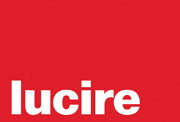|
The week has reflected the more austere times the fashion world is facing.
Whereas in yesteryear we would be received by opulent backdrops and displays
at the MBAFW headquarters in the Overseas Terminal at Circular Quay, this
year felt decidedly pared down in comparison.
Goodie bags were insufficient or non-existent in some cases, with
an exception being the very nice Oroton delegate bag. The event
was decidedly more humble, but, nevertheless, you could still see
people dressed “nicely” and wearing skyscraper heels. And some
à la Derelicte (Zoolander) people—apparently a hobo was
admitted to a show, believed to be a blogger, thanks to some
bloggers’ taste of dress!
Fashion was presented with the dignity
and flair usually carried by creatives, who will face anything with
the chin up, making the best of any scenario. We are here to
create beauty and a brave new world struggling to get out of the
effect of the GFC. But when you hear about labels
like Little Joe Woman and Lisa Ho facing serious difficulties, you
can only imagine what it is like for most of us. So world, be brave,
and spend on the real artists before you kill beauty!
It was a relief to still see Redken, always ready to address our
distressed tresses, messed up by busy days of shows and, this time,
Maybelline was also present to address our faces as make up wore
out during the day.
The format was somewhat different this year, with non-catwalk exhibitors
showing exclusively from suites at the Shangri-La Hotel nearby,
which made them a bit more difficult to spot. Previously a
great number of them would have been in the space preceding the
Box, upstairs from registration.
I have seen a renaissance of the peplum during this week, and a decidedly
classic, 1940s–1950s silhouette emerging from many. Grecian goddess-styled draping remains present in Australian fashion but you will
also see lace and feathers or feathery effects heavily featured
next summer. Pastels, whites, blacks and golds dominated in many
collections, and Aztec-like as well as animal prints made their appearance
in a few. There was also a desire to break from the mould in men’s collections,
whilst keeping them still wearable and masculine. And so, these
were my picks.
Aurelio Costarella
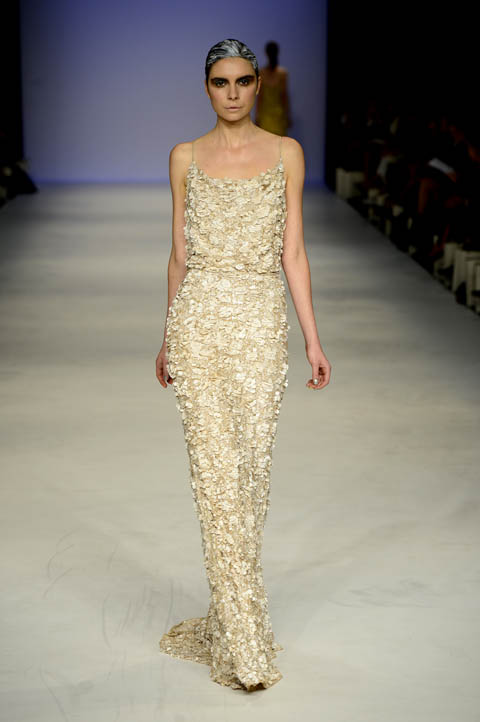
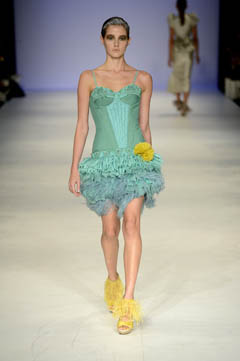 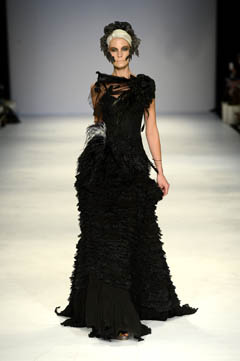
Aurelio presented a sumptuous collection where Famille Verte and Famille
Rose Chinoiserie colours were present: rich hues of greens and yellows,
exquisite pinks, other pastels and bone white. Aurelio’s inspirations
for this collection were fashions and art from the Victorian, Edwardian
and Belle Époque periods, as well as a hint of Renaissance and works
by Belgian artist Joos van Cleeve.
Superbly well tailored and crafted
corsets made their entrance, with a mastery in cut and manufacture rarely seen nowadays. Exquisite beading and draping could
be seen in some items, whilst others featured spectacular handmade
raffia laces, expert draping, and ostrich feather fringes and embellishments,
peplums and large, sculptured rosettes at the back for corsets.
My favourites
were: the opening piece, the Lucretia dress, like a black swan dream
of soft glamour and feathers; the Ivy Lace dress, with such depth
of texture it looked like a botanical dream; the Stamen Bead Tulip
dress with such a beautifully draped skirt and dreamy beading that,
as a departure to the other styles, reminded me of the banded colours
of the Australian desert at dusk. Its long version, the Mosaic Hobble
dress, was also one of my favourites. Also I much loved the Hearts
Ease dress in a bluish wasabi colour, a dream corset with a feathery
tutu skirt; and the Crush sequin dress and its long gown version,
a simple cowled dress with such magnificent embellishments, in hues
of gold and honey, that you could see and almost feel their texture
even from a distance and hear the rustling of the gown as the model
walked.
I have to commend the awesome headpieces by Reny Kestel,
which adorned a good number of the outfits. All in all, flawless,
expert cuts and tailoring, hand-crafted materials, unique colours,
glamour and elegance that most don’t dare to present. Vive Aurelio
Costarella! More on Aurelio in a future write-up, as I had the privilege
of being invited to personally interview him.
Jayson Brunsdon
Always and for a long time one of my favourites, Jayson presented
his spring–summer 2012–13 collection in an installation that he, superbly well,
styled himself, opening, unusually, with a male model wearing Arthur
Galan AG—eye candy to lure the ladies in and put them in a sexy
South American mood.
The inspiration was clearly 1950s with a suggestion
of Argentine Estancia, perhaps in the honour of Evita as herself
and as she was represented by Madonna. Apparently, a trip to Buenos
Aires inspired Jayson and, with it, the inherent sensuality and
romance of Latin America. Peplums, full skirts, fitted, beautifully
tailored tops and jackets, lace layered on contrasting fabrics,
lace pedal pushers, pastel tartan in hues of delicate blue, powder
pink, silver, eau de Nile and a brief incursion of leopard print
in some.
My standouts were the fantastically cut Madame gown, with
a silver lace detail; a Marilyn dress in silver sequin and georgette;
the petal-lace Desire dress; and the New Look dress which was paired
with a Romance jacket. But it was hard to pick favourites in a collection
so full of femininity and delicacy, very much up my alley. A look
that was sophisticated at the same time as accessible was achieved. Very feminine, very wearable, very
Jayson. What I like about him is that his signature can be clearly
seen throughout all his collections.
Aje
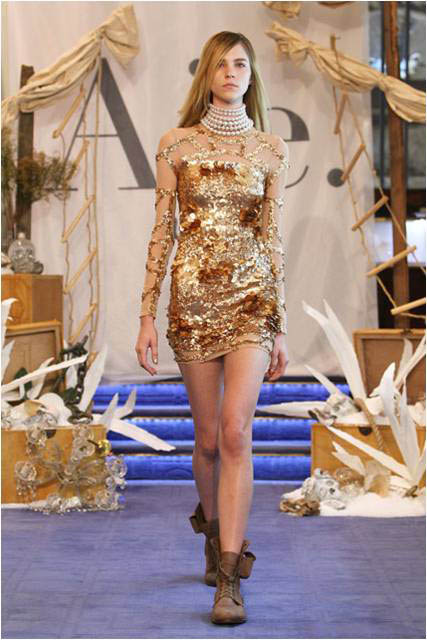
The show was held off-site at the magnificent Paspaley store at
2 Martin Place and was, arguably, the first properly produced show
I have attended during the week. It used to be the norm for designers
to show at magnificent locations and offer champagne and
other delicacies as the preamble to their shows, which properly
set the mood for the luxury and beauty that was to come. During
this week, this was the only show that reverted to such a lovely
custom.
I could see the inspiration before I learned its name: The Shipwrecked Ball. Marine hues of floating algæ, barnacles, sand, shells, lace like coral formations, and weedy
sea dragons all came to the mind as the models strutted around an undulating path made with chairs around the counters at Paspaley. The styles were original and told the story superbly well. The fabrics
were diaphanous and with subtle as opposed to vulgar bling. (Yes, there is bling and there is bling. You have to know your bling.)
I saw a resurgence of the bustle and long trains, worn long both
with micro minis and trousers, though this has not been unique to
this collection as Lagerfeld put it out a couple of years ago.
Once again, whites, golds and pastels were featured, as well as
geometric patterns beaded in bright colours, reminiscent of 1960s’
Aztec-inspired graphics.
I had the opportunity to speak to the label’s national sales agent who showed me the garments up close. I discovered,
to my delight, that the garments were beautifully finished, the fabrics as fine as they looked from a distance. The beading was properly done
on finished garments: all edges were properly finished and it flowed from back to front, covering seams. This is definitely a label to watch and it will
go to many more places. continued 1 | 2
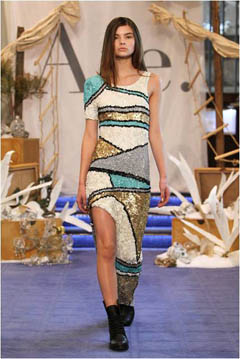 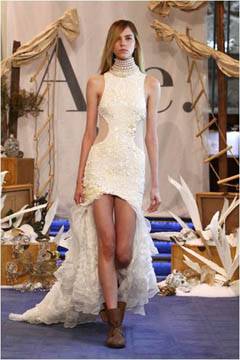
Aje |
 |
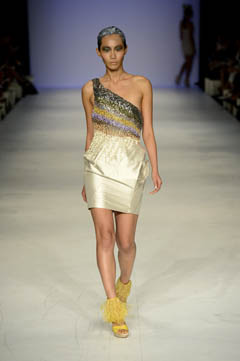
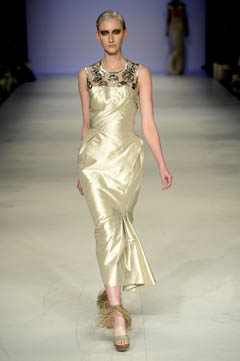
Aurelio Costarella
Romance Was Born
Romance Was Born opened the week at an empty pier in the Sydney Theatre Company.
I have to say, this year they were wearable, whereas before you
could argue that they leant a little bit too much towards costume.
The graffiti backdrop, revealed by a flap being
dropped down where the models then walked, reflected a comic hero–New
York–Gotham kind of feel, declaring the idea as A Nameless Land,
A Timeless Time. What came out was bold, as you can expect from
RWB, but decidedly wearable, with a variety of sometimes-clashing
comic prints in jewel-like and primary colours. What stood out for me was a very rich mustard yellow, sometimes striped with
black, à la bumble bee. In addition to comic book prints, I could
see hints of the animal with polka-dot combinations, as well as
an Aztec Central American influence in some. Peplums, sculptured
shoulders and classic lines were definitely in and the models’ styling,
with very prominent arched, glittery eyebrows and red lips, with
a fiery flame red colour, was very effective.
The men’s show
The general feel was one of wanting to break from the normally
restrictive and boring boundaries of typical menswear, whilst by
and large producing items that are wearable by men. Bi-coloured
trousers were featured in more than one collection, as well as longer
and asymmetrical hemlines on shirts. A lean by some towards “tribalism”
could also be seen—with insinuations of Polynesian–Māori as well
as Himalayan–Mongolian.
I liked some of the lapel-less jackets and
panelled bi-coloured trousers by Britten. I loved Zadar's innovation,
presenting both bi-coloured trousers (back different to front) and
asymmetrically buttoned shirts. I like the fact that they presented
suits in hues other than black and grey. There was an extraordinary
leather jacket by Kalb and Etiw; the swimwear by Nathan Paul was
both cheeky and nice, with some different prints featured on “budgie
smugglers” worn by models very worthy of them.
I could see many
ladies with eyes as big as plates, fanning themselves frantically
and, no doubt, with hard-beating hearts. I could make no such expressions
as I had my equally good-looking husband by my side.
Roopa Pemmajaru
Roopa Pemmajaru presented a collection of pared-down shift dresses
and caftans. Very wearable resort-wear or daywear and I saw, once
again, Aztec influences, animal print and some Egyptian influences
on what was a collection mainly dedicated to the beauty of print
properly done on silk.
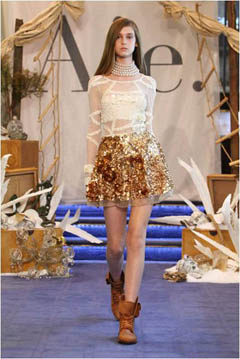
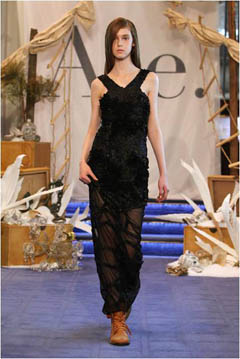
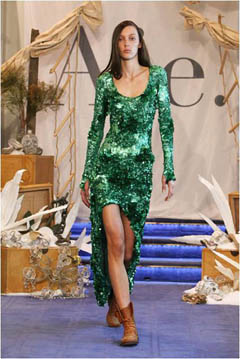
Aje
| Related articles |
 |
Topping the charts with help from Vancouver Fashion Week
Roanna Bell looks at the offerings from Vancouver Fashion Week to see what the key
trends and emerging shapes are for autumn–winter 2012–13
photographed by Stan Lau, Eugenio Flores and Lawrence Lu |
 |
Paris screams fashion, out loud
Fashion doesn’t stop just because the collections aren’t in town. Lola Saab looks at Guy Laroche, Pollini and Olympe75018
some photographs by François Ollivier/Abonnedistance |
 |
Paris’s fashion craze
Lola Saab continues her look at Paris Fashion Week’s autumn–winter 2012–13 season, examining in greater depth the collections from Allude, K11, Valentin Yudashkin, Basil Soda
and Masha Ma |
|
